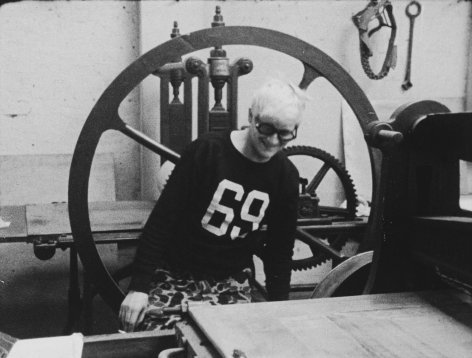ART THROUGH GLASS
Flow V
by Adam Barker-Mill
30th January to 27th February 2023
in the Gallery window
FLOW V is a continuation of the FLOW series one of which we showed here at the Gallery in March 2022. The ongoing series has been exhibited at John Hansard Gallery, Bartha Contemporary London and the Slewe Gallery in Amsterdam.
A fascination with light has been a constant focus throughout his career. The illumination of the local Mendip caves was an early inspiration. He has always been intrigued by the mechanics and workings of cinematic equipment, and has taken advantage of developments in technology (from the humble light bulb to tungsten-halogen to LED). The constantly moving and changing light source that is the sun has also played a significant role in his work: “My understanding of how to use light comes out of that formative cinematographic experience – however different the end result.”
Born in 1940 in Wookey Hole Somerset Adam Barker-Mill started his career in filmmaking before devoting himself to his art practice in the early 1980s. As a highly respected cinematographer, Barker-Mill worked with a number of notable filmmakers throughout the 1960s and 1970s. He had long collaborations with the directors James Scott, known for A Shocking Accident, (Oscar winner for Best Short Film of 1983) and Barney Platts-Mills known for Bronco Bullfrog (1970) and Private Road (1971).
Adam Barker-Mill interviewed by Adrian Dannatt for MUBI, January 2021
‘Adam Barker-Mill is the only professional cinematographer to have switched careers and become a successful artist instead, and his first major retrospective at the Kunstmuseum Ahlen makes clear the connection.“Obviously it is all about light” admits the artist, “light is the very essence of cinematography and light is also the main material of my current work.” In fact Barker-Mill’s career as a cameraman is intriguing in itself, having shot both an Oscar winner and politically radical footage, with some of the most innovative independent British directors of the era, from cinema verité to structuralist experimentation. But in 1985 he gave this all up to concentrate on creating abstract and largely sculptural art works, an ambitious oeuvre now given full rein throughout this German museum. Barker-Mill’s connection to cinema is not only intellectual and visceral but physical, with a love for the machinery of creation; aged nine he became projectionist at his prep school, “taking the film out of its box, lacing it all up, then I sat next to the projector making sure not to burn the film. I remember a thriller with a charred hand clasping an electric rail and I turned up the volume very high to give all the other boys nightmares, the only creative thing I could do was turn up and down the sound.”
In 1962 Barker-Mill moved to Cornwall and tried his best to be a painter but soon found himself more interested in experimenting with a sophisticated form of colour ‘animation’ using 8mm film. These were ‘Chromat’ compositions with one bright rectangle set against another and changing independent of each other; “To avoid producing any image the camera was pointed directly at a skylight with the lens defocussed, so only light was recorded. I could manually rewind the film in the camera whilst mask- ing the gate with rectangular stencils and progressively opening up and stopping down the lens while the film was running. It was quite complex, I had to adjust the f-stops to create the dissolve between one colour or another.” These experimental films, direct precursors of his later work, were projected once onto a very high ceiling at his mother’s house and then seemingly lost.
Enrolling at the London School of Film Technique on Electric Avenue in Brixton he was hired by the performer-politician Screaming Lord Sutch to make a music video; shot on 35mm black and white, a single shot on a tripod, this was cut up with black leader to make a dazzling strobe on screen, curiously enough predating Tony Conrad’s The Flicker. Sutch’s film was shown on a gigantic screen at the local Odeon in Brixton where it literally fell to pieces on the projectionist’s floor as the cement joints broke. Barker-Mill’s first job was in a cutting room on Wardour Street as Probationary Trainee Assistant Editor on the 1965 documentary CHINA! directed by Felix Greene. This was followed by a stint teaching film at Bath Academy of Art where he made a 10-minute short about the projectionist at the local fleapit, the Regal Cinema in Corsham. “This was the first film I directed, shot and edited. I really liked it when he opens up the lamp house so we have a sudden burst of light, a carbon arc, a very bright abstract moment.”
He also worked on his first collaboration with longtime friend the director Barney Platts-Mills, making a documentary on the Steiner school in Bristol; “it was an hour long and more or less bankrupted the film department, classic cinema verité with sync sound, we had hired an expensive 16mm French Éclair camera just because of its link with the Nouvelle Vague and our hero Raoul Coutard.” Whilst at Corsham Barker-Mill also worked on a film about the artist Oskar Schlemmer, shot at night with the radical director Marc Karlin, now considered the ‘lost hero’ of British structuralist cinema. Barker-Mill worked with Karlin again when they were approached by Chris Marker to film the Peugeot production line in Belfort, as he had been banned from filming there, as a known political agitator. “Our cover story was that we were making a film about the motor industry in the Common Market. We first set up a formal interview with the CEO of Peugeot in his Paris office (to reassure them that we were respectable). I didn’t bother to load any film into the camera, we just pretended to be interviewing him, to make it look legitimate. We were then allowed to film the production line at the Peugeot factory in Belfort, with Jon Sanders on sound. Chris Marker used our footage.” Through Sanders Barker-Mill also got a job on The Great Rock ’n' Roll Swindle for Julian Temple, shooting Malcolm McLaren acting as himself, with Vivienne Westwood as art director, shooting at the SEX clothing shop and at Highgate Cemetery. He also shot various pop videos, including for Donovan and even a gang warfare B-movie in Clacton on Sea.
But Barker-Mill is perhaps best known for his long collaboration with the director James Scott, starting in 1967 with a documentary on the painter R.B. Kitaj. This was closely followed by Love’s Presentation. David Hockney is seen in his studio creating a series of etchings, just as twenty years later Barker-Mill himself would begin etching. Shot in black-and-white, the credits are scrawled in Hockney’s own handwriting. The Arts Council were wary of backing the project, “they were afraid nobody would know who he was!” This was followed by a groundbreaking film on pop artist Richard Hamilton which used a variety of techniques from reshooting a TV monitor to a commercial break and even a fake cinema trailer: “ it was technically very demanding, using live footage of a Douglas Sirk movie on which he’d based a series of prints.” This was followed by The Great Ice-Cream Robbery on Claes Oldenburg, filmed at the Tate and shown on two separate screens side by side, with twin projectors like Warhol’s Chelsea Girls.
All of these by Scott have been reissued by the BFI, including Chance, History, Art with interviews with the Sex Pistols designer Jamie Reid and artist-criminal Jimmy Boyle, “ we filmed on Betamax which was better than VHS but didn't catch on, one could film for 20 minutes continuously without the expense, then we re-filmed it off the TV monitor onto 35mm, so it now only exists as a roll of film.” Barker-Mill also shot A Shocking Accident which won Scott an Oscar for Best Short in 1983, “ I shot on 35mm colour and it was tricky to try and film an apartment in Naples when actually in London, getting the balance right between interior and exterior with the bright light of the south.” Scott moved to Hollywood to start work on Loser Takes All for Miramax which was soon mired in strife with Harvey Weinstein who even attempted to change the title of the original novel by Graham Greene on which it was based.
Meanwhile Barker-Mill was still collaborating with Platts-Mills, with whom he shot the seminal Bronco Bullfrog and the cult classic Private Road, starring Bruce Robinson who seemingly adapted elements of the story for his own Withnail & I. Barker- Mill was also DP on the notorious shoot for the most ambitious, if not dangerous of Platts-Mills films, Hero, shot on 16mm col- our in the Scottish Highlands. His now wife Carolyn Barker-Mill captures this well in the monograph on the artist published by Bartha Contemporary Ltd in 2015; “ Hero brought together Old Bohemia Notting Hill and young offenders from working class Glasgow gangland. Adam was Director of Photography and led a crew of camera assistants, focus puller, clapper loader, grips and and electricians. Our courtship was signed sealed and de- livered when Adam took me up in a helicopter over the Corryvreckan whirlpool as he filmed the broiling mass. In those days Adam worked back to back on films. He was admired for his skill in naturalistic lighting, for framing a shot and for his ability with a steady hand-held camera. Adam decided after one of his films had won an Oscar not to follow the director to Hollywood but to give up movies altogether on a high and stay in Southampton and make art.”



